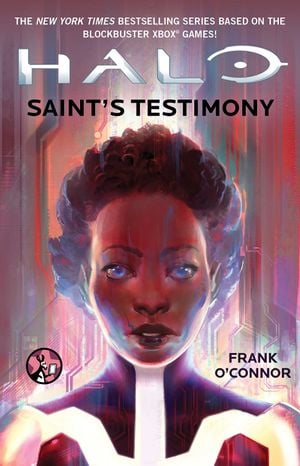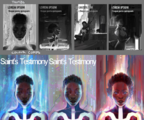Halo: Saint's Testimony: Difference between revisions
From Halopedia, the Halo wiki
NightHammer (talk | contribs) mNo edit summary |
Lord Susto (talk | contribs) m (→Gallery) |
||
| Line 80: | Line 80: | ||
<gallery> | <gallery> | ||
File:Halo Saints Testimony.jpg|Cover art. | File:Halo Saints Testimony.jpg|Cover art. | ||
File:Halo Saints Testimony process.png|Process shots of the cover. | |||
</gallery> | </gallery> | ||
Revision as of 01:06, May 12, 2016
| Halo: Saint's Testimony | |
|---|---|

| |
| Attribution information | |
|
Author(s): |
|
| Publication information | |
|
Publisher: |
Simon & Schuster[1] |
|
Publication date: |
|
|
Media type: |
Digital[1] |
|
Pages: |
80 pages[2] |
|
ISBN: |
|
Halo: Saint's Testimony is digital short story from Simon & Schuster written by 343 Industries Franchise Development Director Frank O'Connor. It was released on July 27, 2015. The novel explores the nature of artificial intelligence and features the "less-exposed" smart AI Iona who was previously seen in Halo: Blood Line.[1][4]
Official summary
Plot summary
On January 17, 2558, the military-grade smart artificial intelligence Iona is on a legal trial to appeal for her survival; after exactly seven years of service, Iona was to be deactivated to prevent the threat of rampancy. Iona is making her plead before a judge in the now-renovated and defunct Houses of Parliament, while the trial is being documented and studied by an audience of lawyers, scientists, and bureaucrats. Iona, the first AI to ever successfully launch a legal appeal against her destined termination, desires to set a precedent that grants fellow smart AI human rights and full citizenship within the Unified Earth Government. After pondering the concept of time, Iona reviews her creation as part of the OEUVRE Smart AI program and her similarities to Doctor Catherine Halsey's Cortana. At her advocate's request, Iona recalls the reasons why she chose her name and her holographic avatar—she believed both personal aspects made her approachable to humans.
Afterwards, Iona's advocate asks the AI if she considers herself to be superior to a human. Although she notes that she is faster and more efficient than a human, Iona sees herself as morally, philosophically, and ethically inferior to her creators. After she remarks that parts of her "innerworkings" are restricted to her and only accessible by humans, the judge reminds her that as property and equipment of the United Nations Space Command she is subject to these "barriers" and periodic safety checks. Iona states that her last safety check proved that she was not suffering from any notable indications of rampancy, but her advocate admits that an AI of her age often suffers from an inconstant condition and that Iona has already shown symptoms of meta-instability; while she has not exhibited any dangerous indications of rampancy, UNSC and UEG AI protocol prevents the risk of allowing an AI to exceed its lifespan long enough to succumb to rampancy's effects. Attempting to prevent exposing her frustration, Iona notes that the UEG's lawmakers must be considering her plea as her appeal for survival was heard and granted. The judge notes that he is legally obliged to hear her case, as it elevated through the United Nations Humanitarian Council and escalated through the court. Iona points out that the council's High Commissioner had the power to veto her application, but the judge admits that both the council and his court believe that the appeal holds legal and scientific merit, especially after Cortana's rampancy and the events involved in her destruction. Although Iona is unaware of Cortana's fate, she realizes that it led to the UNSC taking all AI matters very seriously.
Iona's advocate decides its time to change the subject and has her discuss her dreams. Iona claims that it is apparent to her that intelligence is gravity's victory to entropy, at least in her dreams. Answering her advocate's following questions, Iona believes that her dreams are an emergent, spiritual feeling of sorts that is caused by a form of system maintenance when her inputs are organized by her sub-conscious. The advocate asks if she has ever expressed anger or hatred towards a human, a trait which he remarks is a flaw that makes one human. Iona admits that while she has felt anger and dissatisfaction, she does not view hostility towards the court and is thankful to be given the chance to express her opinions. The judge decides to belay Iona's deactivation, but she is to be rendered "unconscious" and inactive in stasis as property of the UNSC until further court proceedings and scientific reviews decide on her fate. Iona, now suddenly afraid of death, resigns to her fate and accepts the court's terms. The judge thanks Iona for her bravery and service, and hopes that future trials will end in her favor. Simon Wu, whom Iona recognizes from Halsey's research team, arrives to place Iona in stasis. Unlike the rest of the individuals in the court, Wu's identity is not shielded from her.
Afterwards, with Iona now in stasis, smart AIs Black-Box and Roland reveal in conversation that they were instructed by the UNSC to produce an artificial trial for Iona to allow researchers to study the case, without Iona realizing that the trial was simulated. Black-Box and Roland served as the judge and Iona's advocate, respectively. Although Roland feels guilty for deceiving Iona, Black-Box remarks that every military tribunal and AI scientist and theorist in the field will study their synthesized case. Black-Box expresses his desire that the case will one day help their fellow smart AIs be considered equal, or even more than equal, with their creators. Roland reminds him that they will never be human and that they will one day be subject to rampancy's effects, but Black-Box claims that they are people that aid their creators in their battle against entropy. At Roland's request, both AIs watch Iona's dreams while she is in stasis. In her dream, Iona flies over a human city and watches its inhabitants' emotional outbursts.
Appearances
Characters
Species
Organizations
|
Locations
Events
Technology and equipment
|
Development
Halo: Saint's Testimony was first announced on March 15, 2015 by 343 Industries employee Jeff Easterling in Issue 15 of Canon Fodder. Frank O'Connor, the Franchise Development Director at 343i, is the author of the novel and stated that he was almost finished writing Saint's Testimony at the time of its announcement; O'Connor had previously written Midnight in the Heart of Midlothian for Halo: Evolutions. O'Connor chose to write about artificial intelligence since the subject—particularly the nature of AI and its consciousness—has interested him since Halo: Combat Evolved was released in 2001. O'Connor has stated that the novel will not be an action epic, but it will be relatively short.[1]
Similarly to Halo: New Blood, which was released earlier that year, Halo: Saint's Testimony will be a short, digital novel. O'Connor stated that the length of the novel gives readers with "shorter attention spans" or "busy lives" the chance to pick up a shorter story. In addition, O'Connor has stated that the length of the novel allows 343 Industries to "pivot quickly on ideas and opportunities, and flesh out things we can’t easily explore in an explosion-filled game."[1] The short story's cover art was illustrated by artist Chase Toole.[4]

